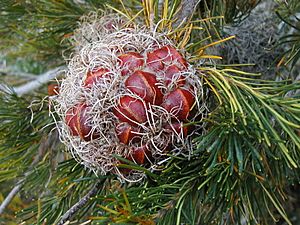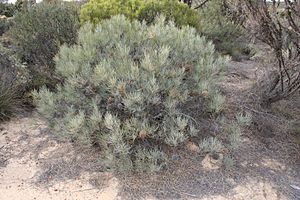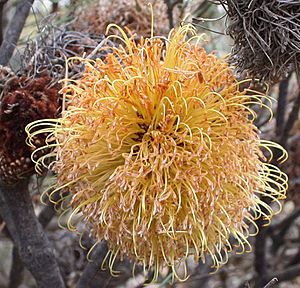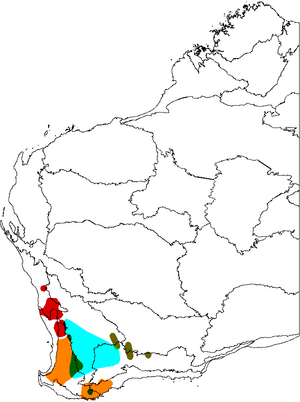Fox banksia facts for kids
Quick facts for kids Fox banksia |
|
|---|---|
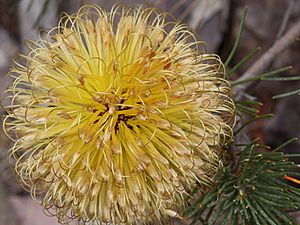 |
|
| B. sphaerocarpa var. sphaerocarpa at Stirling Range National Park | |
| Scientific classification | |
| Kingdom: | |
| (unranked): | |
| (unranked): | |
| Order: | |
| Family: | |
| Genus: | |
| Species: |
B. sphaerocarpa
|
| Binomial name | |
| Banksia sphaerocarpa |
|
| Varieties | |
|
|
The Banksia sphaerocarpa, also known as the fox banksia or round-fruit banksia, is a type of shrub or small tree. It belongs to the Banksia plant family, called Proteaceae. This plant usually grows as a shrub about 1 to 2 meters (3 to 7 feet) tall. In the northern parts of its habitat, it is often smaller.
The fox banksia has thin, green leaves. Its flowers grow in round spikes that are brownish, orange, or yellow. You can see these flowers from January to July. This plant grows all over the southwest of Western Australia. It prefers sandy soils and is often the main plant found in scrubland or open woodlands. Birds, mammals, and insects help pollinate it and also use it as a food source.
The fox banksia was first described in 1810 by a botanist named Robert Brown. Its scientific name, B. sphaerocarpa, comes from Ancient Greek words meaning "round" and "fruit," because of its round seed pods. Over time, scientists have changed how they classify this plant. Several types of plants once thought to be part of B. sphaerocarpa are now considered their own species. Today, most experts recognize five different types, or varieties, of the fox banksia.
The largest variety, B. sphaerocarpa var. dolichostyla, is sometimes even called its own species, B. dolichostyla. The fox banksia is not considered endangered in Western Australia. However, two of its varieties, latifolia and dolichostyla, are listed as rare or poorly known. These plants are not often grown in gardens.
Contents
What the Fox Banksia Looks Like
The Banksia sphaerocarpa can look different depending on where it grows. Its size, flowers, and leaves can vary. Because of these differences, scientists recognize five main varieties.
This plant is usually a shrub, growing between 0.4 and 2 meters (1.3 to 7 feet) tall. Plants in the northern areas are smaller, while those in the southeast can grow taller. Some varieties, like dolichostyla and sometimes caesia, can even reach 4 meters (13 feet) high.
All varieties have a special swollen root called a lignotuber. This helps the plant regrow after a bushfire. New stems are a bit hairy at first, but they become smooth as they get older. The leaves are stiff, narrow, and long, measuring 2.5 to 10 cm (1 to 4 inches) in length. Most varieties have leaves about 1 to 1.5 mm wide with a pointed tip. However, the latifolia variety has wider leaves (2 to 2.5 mm) with a blunter tip. The leaves are usually green, but some varieties like caesia and dolichostyla have a pale blue-grey color.
The flower clusters, called inflorescences, are usually round. They are about 5 to 8 cm (2 to 3 inches) across. Some larger types, like dolichostyla, have more oval-shaped flower clusters. The flowers bloom from January to July and can be yellow, orange, or brownish. It takes about five to eight weeks for the flowers to fully develop.
These flowers produce a lot of nectar, so much that it sometimes drips to the ground! As the flowers get older, they turn brownish and grey and stay curled around the flower spike. Each spike can develop up to 60 seed pods, called follicles. These pods are hairy at first, then become smooth and golden brown. They are about 1.5 to 3 cm (0.6 to 1.2 inches) long. The seeds inside are wedge-shaped and measure about 2 to 2.6 cm (0.8 to 1 inch) long.
Smaller fox banksia shrubs in the north can look similar to B. micrantha. However, B. micrantha has smaller flower clusters and flatter seed pods.
How Scientists Classify the Fox Banksia
The first time a fox banksia plant was collected by scientists was in December 1801. This happened during a trip by the ship HMS Investigator to King George Sound. The plant was found by the English botanist Robert Brown.
Brown officially described and named the species in 1810. He chose the name sphaerocarpa because it means "round fruit" in Ancient Greek, referring to the plant's round seed pods.
Over the years, many botanists have studied and tried to organize the different types of Banksia plants. For a long time, the definition of B. sphaerocarpa was very broad, meaning it included many different plants. But in 1981, botanist Alex George made a big change. He recognized several plants that were once considered B. sphaerocarpa as their own separate species. These included B. micrantha, B. grossa, and others.
Today, Alex George's classification from 1999 is still the most widely used. He places B. sphaerocarpa within the Banksia genus, in a group called Abietinae, which includes species with round fruits.
Here's a simplified look at where B. sphaerocarpa fits in the Banksia family:
- Banksia
- B. subg. Banksia
- B. sect. Oncostylis
- B. ser. Abietinae
- B. sphaerocarpa
- B. sphaerocarpa var. caesia
- B. sphaerocarpa var. dolichostyla
- B. sphaerocarpa var. latifolia
- B. sphaerocarpa var. pumilio
- B. sphaerocarpa var. sphaerocarpa
- B. micrantha
- B. grossa
- B. telmatiaea
- B. leptophylla
- B. lanata
- B. scabrella
- B. violacea
- B. incana
- B. laricina
- B. pulchella
- B. meisneri
- B. nutans
- B. sphaerocarpa
- B. ser. Abietinae
- B. sect. Oncostylis
- B. subg. Banksia
In 2008, Alex George officially recognized two more varieties: B. sphaerocarpa var. latifolia and B. sphaerocarpa var. pumilio.
Varieties of Fox Banksia
The Banksia sphaerocarpa is found across Western Australia and has five recognized varieties:
- B. sphaerocarpa var. caesia was first described in 1981. It can grow up to 2 meters (7 feet), or sometimes even 4 meters (13 feet) tall. It has yellow flowers and bluish-grey leaves. You can find it in the central and southern Wheatbelt region.
- B. sphaerocarpa var. dolichostyla (Ironcap Banksia) was also described in 1981. This is the largest variety, growing as a big shrub or small tree up to 4 meters (13 feet) high. It is larger in all its parts compared to other varieties. It grows in a small area east of Hyden in the eastern Wheatbelt.
- B. sphaerocarpa var. latifolia was described in 1870. It is a small, round shrub that grows to about 50 cm (20 inches) tall. It is found near the south coast, between Denmark and the Porongorup Range. It grows in open forests with Eucalyptus marginata and E. calophylla trees.
- B. sphaerocarpa var. pumilio was first described in 2008. It is a small shrub, usually less than a meter (3 feet) tall. Its name, pumilio, comes from the Latin word for "small," referring to its flowers. It grows from Tathra National Park south to the Chittering valley.
- B. sphaerocarpa var. sphaerocarpa is found over a wide area, from the Darling Plateau near Perth to the Whicher Range in the southwest, and southeast to the Stirling Range. Plants found north of Perth that used to be called this variety are now classified as var. pumilio.
Where the Fox Banksia Lives
The Banksia sphaerocarpa is found across a large part of southwestern Western Australia. Its range stretches from Eneabba in the north, down to the Whicher Range, Nannup, Albany, and Jerramungup in the south. It also extends east towards Hyden.
This plant mostly grows in sandy soils on flat or gently sloping land. It is commonly found in shrubland, mallee areas, or open woodlands.
Conservation Status
Overall, the B. sphaerocarpa species is not considered to be in danger of disappearing. However, two of its five varieties are listed on the Declared Rare and Priority Flora List.
The variety B. sphaerocarpa var. dolichostyla is officially listed as "Declared Rare Flora." This means it has legal protection under the Wildlife Conservation Act 1950. The variety Banksia sphaerocarpa var. latifolia does not have legal protection, but it is considered a "Priority Two – Poorly Known" plant. This is because very few groups of this variety are known to exist.
Ecology and Life Cycle
Many different animals visit the flowers of Banksia sphaerocarpa. These include mammals, birds, and insects like bees, wasps, ants, and beetles. For example, the New Holland honeyeater bird and the honey possum have been found with pollen from this banksia on them.
Scientists have studied how B. sphaerocarpa reproduces. A study in 2009 looked at populations of B. sphaerocarpa var. caesia in areas where the land had been cleared. They found that the plants rarely pollinated themselves. Most of the time, plants mated with other plants in the same group. However, about 15–33% of the seeds came from mating between plants from different groups. This shows that mating between different groups is very important for the plant's reproduction. Smaller groups of plants had lower rates of seed growth, smaller plants, and less variety in their genes. This suggests that mating between different groups helps the plants be healthier.
Banksia sphaerocarpa is one of five Banksia species that have very unusual flower nectar. Most Banksia species have clear, watery nectar. But the nectar of these special species starts as pale yellow and then gets darker and thicker. Within a day or two, it turns into a thick, olive-green goo, and eventually becomes an almost black, jelly-like lump stuck to the bottom of the flowers. Scientists first noticed this in 1980. They initially thought tiny organisms were causing the color change, but later research in 1996 suggested it's a chemical change from the plant itself.
Like most Banksia species in Western Australia, B. sphaerocarpa can get a disease called dieback. This disease is caused by a water mold in the soil called Phytophthora cinnamomi. In experiments, many plants died within a few months after being exposed to this mold. This shows that the fox banksia is quite sensitive to this disease.
Growing the Fox Banksia
The different varieties of Banksia sphaerocarpa are not commonly grown in gardens. They can be hard to grow in places with wetter climates, like Australia's east coast. Trying to grow them by grafting (joining parts of two plants) has not worked very well.
However, these plants can grow well in gardens that have good drainage, sandy soils, and lots of sunshine. They prefer drier climates, especially those with winter rain, similar to the Mediterranean climate. They can also handle frost. Fox banksias are great for attracting birds, and they flower when many other plants are not blooming. Their seeds do not need any special treatment before planting and usually sprout within 20 to 48 days.


